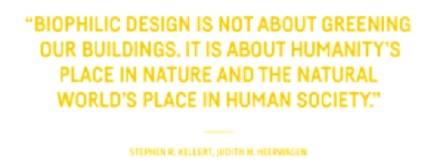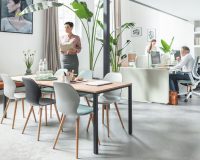Despite all the time we spend indoors every day, we instinctively feel a closeness to nature and a strong connection with it. Biophilic office design offers a new way to integrate nature into man-made spaces, with proven benefits in terms of psychological well-being, physical health, productivity and employee retention.
The following text excerpt comes from an article in Sedus
INSIGHTS N° 10 “Nature at Work”
Nature as part of us
Getting lost in the forest, without mobile phones and other aids, simply being in the midst of greenery … For European nature lovers, this is a brand new feel-good trend (1) that derives from the Japanese practice of “Shirin-Yoku” (2). The literal translation would be “forest bathing” (3) and is an idea developed by Dr. Qing Li in the 1980s. Immersion in nature awakens fundamentally positive feelings in us. It has been scientifically proven to reduce people’s stress and improve mental health, increase serotonin levels and strengthen the immune system. As a preventive medicine, this is so effective that the Japanese government has included this application in the country’s health care system.
Forest bathing is a perfect example of people seeking new ways to connect with nature, driven by an instinctive and genetic affinity for all living systems. It is a physical and psychological connection that the biologist E. O. Wilson called “biophilia” and defined as “the innate human urge to connect with (…) life and life-like processes” (4). In other words, biophilia is the reason why we love crackling fires, looking out to sea, enjoying the company of animals and the invisible power we experience when looking at a familiar landscape.
Experiencing nature with all our senses
We experience the world with our senses – primarily through sight, touch, smell, hearing and taste. The basis of biophilic design is its ability to use these senses to satisfy unconscious needs and connect on a physical and emotional level. The natural system takes on some of the recurring aspects such as unpredictability or a sense of protection or danger.

Examples from around the world show how biophilic design is now routinely used to support learning, movement and sensory enhancement, stress reduction and relaxation, and to improve overall health. The workplace is one of the man-made environments that could benefit most from the application of biophilic design principles. This is particularly the case because biophilic design has been shown in numerous research studies to increase people’s ability to concentrate, their productivity and creativity, to enhance individual well-being and to improve recruitment and retention.







